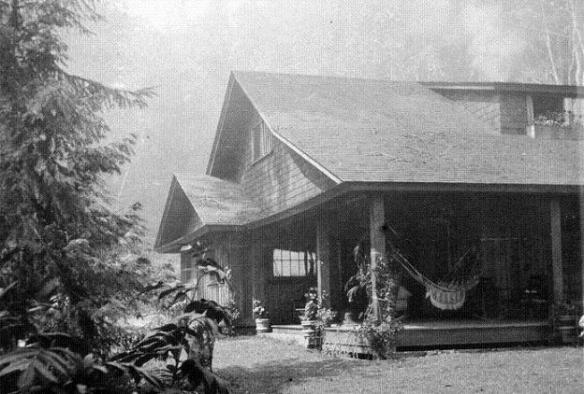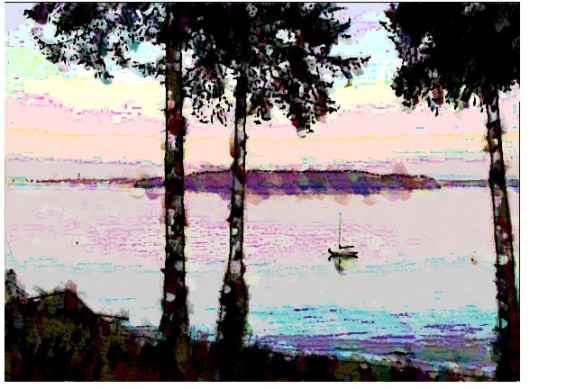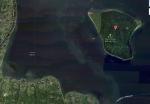
The main house of the Trimble Estate on Blake Island featured a large veranda, lush gardens, and a rustic feel. It was built about 1918 and burned — mysteriously — in the late 1940’s. Was it an arsonist? Native Americans? The Navy? Now we know what happened! Photo from the Washington State Parks Collection.
By Russell Neyman.
The cause of the fire that destroyed Blake Island’s most prominent structure has been a mystery for nearly six decades, but a Manchester man has come forward to take responsibility for the blaze. Don Winslow, now almost 80, built a 16-foot boat in wood shop class at South Kitsap High School in the 1940’s, and mounted a used five-horsepower outboard motor on it. The temperamental engine was the indirect cause of the Trimble Mansion fire.
About 1948, on one of the boat’s inaugural voyages, Winslow and his friend, Keith Williams, decided to motor over to Blake Island to explore.
“It was a very, very cold and windy day, but we finally neared the shore,” Winslow recalls. “At some point, a wave surge soaked us and our engine, and we couldn’t get it started again. We were tired and cold, so Keith and I decided to go into the abandoned Trimble Mansion to get warm. It was wide open. There were lots of old shake shingles and other wood, so we put some of it in the large fireplace and built a fire. We stayed there several hours.”
The sprawling mansion, at that point, had been deteriorating and vandalized over the course of decades of neglect. Many of the doors and windows were broken or gone, and it was quite common for campers and squatters to take shelter there. Winslow noted that the stairs were rotting and there was plenty of debris around the place.
“After getting warm, we decided to head back to the mainland. The motor still wouldn’t work, so we got a couple of boards and used them as oars and headed over toward South Colby [Harper], since it was the nearest point of land. About the time we reached shore, we looked back toward the island and saw a glow and smoke over where the Mansion was. ‘Holy heck,’ we said. ‘Did we do that?’ We were scared and worried, figuring that an ember from our fire started the blaze.
“We agreed right there and then that we wouldn’t tell anyone.
“The next day,” Winslow recalls, “the newspapers told all about the ‘mystery’ fire, hinting that it might have been arson. Through the years, we occasionally heard other stories about the mansion and the fire, and I always thought back to that cold day and what happened. Neither Keith nor I said a word to anybody.”
The South Kitsap High School graduate went on to a successful career, first working in the Bremerton Shipyard, then as owner-operator of gasoline service stations. He also served on the Manchester Water District. Today, he is retired. Keith Williams died in an automobile accident about ten years ago, according to people who knew him.
In subsequent years, all sorts of theories about who started the fire and why it was burned were offered, ranging from squatters to a deliberate effort by the United States Navy to render the island uninhabitable. There was also talk that the building was destroyed to discourage developers or by Native Americans who wanted the Whites to leave.
Originally called High Island by the Native Americans and, later, Smugglers Island by homesteaders, the 574-acre island is situated between Manchester and Southworth. The island has very little clean drinking water, so it has never proven to be a suitable place for permanent homes. It was a traditional camping ground for the Suquamish Tribe and folklore has it that it was the birthplace of Chief Sealth, from whom Seattle took its name.
It was first observed by British explorer George Vancouver in 1792 but was not given its current name until the United States Exploring Expedition visited again in 1841. It was logged completely by the 1880’s, making the property virtually worthless for about a decade. However, as the timber regenerated, Seattle millionaire William Pitt Trimble took note of the isolated but picturesque property, purchasing it just after the turn of the century. In an effort to put his own name on the property, he established an “technical” post office, naming it “Trimble Island.” Of course, this did not change the name of the island itself, though Trimble hope that would be the case. He and his wife, Cannie, built a magnificent estate – complete with the expansive mansion, huge dock, horse stables, orchards, warehouse structure, and beautiful manicured gardens – that they occupied from 1917 through 1929.
Not many photographs or documents relating to the Trimble Estate or early Blake Island have survived. The Yukon Harbor Historical Society welcomes contributions relating to this subject – photographs, anecdotes, old newspaper clippings – that might help tell the complete story of Blake Island. Contact information is noted in the right-hand column.
The Trimble “mansion” was a rambling two-story house of 12 rooms, with five fireplaces on the main floor. The huge living room was 35 by 40 feet, with large Douglas fir ceiling beams. Winslow described the windows, doors, and millwork as “impressive” even in it’s deteriorated state when he and Williams were there.
Across the front of the house was a broad verandah that overlooked the large front lawn and extensive formal gardens sloping gently toward the water. The estate also had a vegetable garden, a large pasture for horses, a cement tennis court, and a wooden swimming pool. Three caretakers maintained Trimble Island all year-round. Mrs. Trimble forbid firearms of any kind on the island, so deer and other wildlife flourished. Visitors marveled and the beautiful estate and the natural setting. Designing the house and grounds became a passion with her, and Cannie’s name became synonymous with the island.
The glory years for the island came to a tumbling end in 1929 for Trimble, first with the infamous stock market crash and then with the tragic death of Cannie in a freak automobile accident. Trimble was devastated and heartbroken. He abandoned the place and went into seclusion, eventually selling it to an investment company in 1936. It came to be known, once again, as Blake Island.
During World War II, the United States Army garrisoned a coastal artillery unit there, and portions of it were reportedly used to store munitions, since that would isolate them from the nearby Bremerton Ship Yard and Manchester Ship Fueling Facilities in event of air attack. The Army’s intentions for the island have always been viewed with suspicion.

Other things have changed through the decades, but Blake Island (shown here in this watercolor rendering by the author) looks the same as ever.
After the war and for decades to follow, the island’s future was in doubt, with several developers and public officials debating varied uses but none came to fruition. There was even talk of rebuilding the mansion, but those plans ended with the now-solved mystery blaze. Eventually, Blake Island was designated as a state park and Native American historical site, with camping, hiking, and boating facilities. Today, 100,000 visitors use the State Park for outdoor recreation each year. There are 12 miles of hiking trails on the island, mostly old service roads. The longest trail, 4.5 miles, circumnavigates the island on the bluffs above the beach. Located on a trail behind Tillicum Village, the foundations of the Trimble family home, and a few other remnants of the estate, can still be seen.
“We caused that blaze and burned the house down, no doubt,” Winslow says. “I think the statute of limitations has long since past, but I might still see a fire department investigator show up on my doorstep one day.”
Copyright Russell Neyman, Yukon Harbor Historical Society – July, 2008 and January 2009.)
===============================================
(See the related essay, “Strolling Through Colby, Summer 1942″ by JoAnn Grant Lorden and a second essay, “A Boy’s Recollections of Blake Island” by a former caretaker’s son in the right-hand column. These features contain additional anecdotes about Blake Island.)
____________________________________________________
Update (July 12, 2012)– We have received additional emails and input about the Trimble Mansion and fire, including an email from Cassandra Trimble, granddaughter of William and Cannie Ford Trimble. The third-generation Trimble woman disagrees with the accounts of a deteriorated estate, but with respect to her family’s insights and family folklore, we have had confirming stories to that effect. Jay Blackburn, who lived in South Colby in the 1940’s and 50’s, says he frequented the estate immediately following the war (and just before the place burned down) and says the fireplaces had collapsed, the stairs were completely fallen, and the doors and windows were missing. Blackburn recalls the news of the fire, but never heard any stories as to the cause. Other individuals who have memories of Blake Island have forwarded their notes, as well, and those remarks are scattered throughout this website.
We have requested that Ms Trimble forward any photos and other accounts for our files, and are hopeful she will be able to assist us in piecing together the island’s history.
One additional note of interest is a comment received from Pat Aitken, great-grandaughter of the Trimbles. She noted that Mrs. Trimble’s correct first name is NOT Cassandra (or Cassie) as reported in countless news and internet sources, but actually Cannie.
This article has created quite a stir since it was first posted on July 19th, 2008. The SEATTLE TIMES called our society and interviewed us, and published a front page feature piece. A few days later, the Associated Press picked it up, and accounts have been published in newspapers throughout Puget Sound, Olympia, and Portland. Needless to say, we’ve had literally thousands of visitors to our site since then.
We continue to search for more information regarding Blake Island, and feel that someone must have more detailed photographs of the Trimble Estate in its heyday or, perhaps, just good stories about visiting the island. Remember, not only has it been a vacation spot as well as a home to the Trimbles, but there were military personnel stationed there during the Second World War.
Please contact us through the information listed in the right-hand column if you have anything to share. –RN.





Is there anything about Manchester State Park on here?
Thank you so much for this information! I grew up in Port Orchard from 1959 until 1974 and had heard so many stories! I love history, old homes (we live in Manette in a 1912 home that we have restored) and all of the details. I got to visit Blake Island back in 1978 and I was so intrigued with the burned mansion and so sorry that it was no longer there! I did see the foundation and my romantic side longed to see photos of it’s former glory. It would be so interesting and fun to finally get to see pix of the home inside and out and the gardens! I hope someone sends them to you! I so enjoyed this!